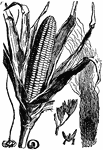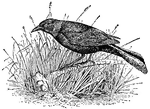
Crow Blackbird
The crow blackbird, or purple grackle, eats a variety of foods. About 48% of their diet contains animal…

Cucumber Leaf
Illustrated is a disease of cucumber leaf. The dying margin shows that the trouble is due to some interference…

Olive
Pictured is an olive branch in flower and fruit. Olives yield oil and are also prepared as a food/condiment.

Human Esophagus
An Image of an esophagus showing how a mass of food, or bolus, passes through the esophagus into the…

Gill-net
A net that catches fish with gill covers in the mesh of the net. This illustration shows a gill-net…
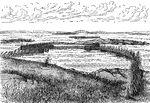
Herring Weir
A fixed trap that fish can easily find their way into, but cannot easily find their way out. This particular…

Pound Net
This net employs a 'Leader', 'Heart', 'Fore Bay', and 'Pound'. Each of these apparatus are constructed…

Fu'sus
Fu'sus is a genus of gastropods, which are allied to the British whelk and American conch, and which…

Jungle-fowl
Jungle-fowl is a general name given to the members of the genus Gallus. The red jungle-fowl, G. jerrugineus,…

Sea Lamprey
A lamprey is an animal which, though often regarded as a fish, differs from a fish in the absence of…

Land Crab
The land crab is a member of the family 'Gecarcinidae', and is remarkable for the curious modification…

Lapwing (or Peewit)
A handsome plover-like bird of Northern Europe and Asia (Vanellus cristatus), also known in Great Britain…
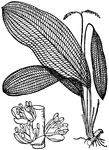
Lattice Leaf
Lattice Leaf is the popular name of a water plant, 'Aponogeton jenestralis', belonging to the order…
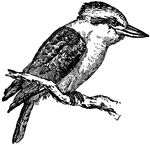
Kingfisher, Dacelo gigas
The Settler's Clock ('Dacelo gigs'), is a very large kingfisher found in Australia, where it receives…

Lemming
A lemming is a small, yellowish-brown rodent, closely related to the vole, and belonging to the genus…

The Lentil Plant
This illustration shows a lentil plant. Lentils are the round, flat seeds of a small leguminous plant…

John the Baptist
"And in those days cometh John the Baptist, preaching in the wilderness of Judaea, saying, Repent ye;…

The Finding of Moses
"And there went a man of the house of Levi, and took to wife a daughter of Levi. And the woman conceived,…
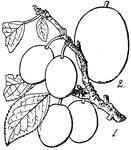
Prunes
Any plum which dries readily, without fermentation, but more particularly to those which contain over…
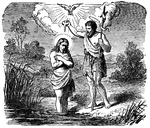
The Baptism of Jesus by John the Baptist in the Jordan River
"And it came to pass in those days, that Jesus came from Nazareth of Galilee, and was baptized of John…
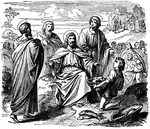
Jesus Feeds the Five Thousand with Five Loaves of Bread and Two Fish
As evening approached, the disciples came to him and said, "This is a remote place, and it's already…

Franks Crossing the Rhine to Establish Themselves on the West Bank as Allies of Rome
A group of Franks, mainly men with a couple of women and children, cross the Rhine River on a wooden…

Abraham and Sarah Show Hospitality to Three Strangers at Their Home
"and he lifted up his eyes and looked, and, lo, three men stood over against him: and when he saw them,…

Isaac Deceives Jacob and Receives Esau's Blessing
"And he discerned him not, because his hands were hairy, as his brother Esau's hands. So he blessed…
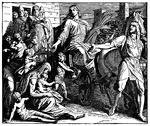
Joseph Collects Wheat as Governor of Egypt in Preparation for the Famine
"48 And he gathered up all the food of the seven years which were in the land of Egypt, and laid up…
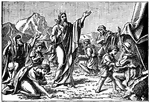
The Israelites Gather Manna Sent by God
"And when the dew that lay was gone up, behold, upon the face of the wilderness a small round thing,…

Jesus Feeds More Than Four Thousand People with Seven Loaves and Two Fishes
"and he took the seven loaves and the fishes; and he gave thanks and brake, and gave to the disciples,…

Lazarus, the Beggar, and the Rich Man
"Now there was a certain rich man, and he was clothed in purple and fine linen, faring sumptuously every…
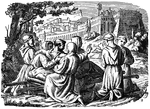
The Death of Saint Francis of Assisi with the Basilica of Saint Francis in the Background
Illustration of Saint Francis being carried on a pallet by five other clergy members. He is emerging…
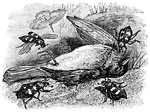
Burying Beetles, Burying a Dead Bird
Also called Sexton Beetles, these beetles bury the carcasses of small vertebrates as food for their…

